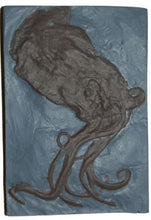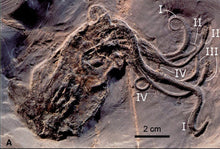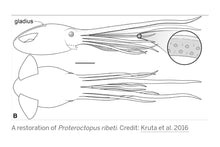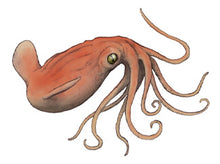
Proteroctopus ribeti was a primitive octopod that lived in the Middle Jurassic. The single fossil specimen assigned to this species originates from the Lower Callovian of Voulte-sur-Rhine in France. It is currently on display at the Musse de Paleontologie de La Voulte-sur-Rhine.
The last photo is of the original authentic specimen.
Proteroctopus ribeti, fossil octopus cast replica
Resin cast measures
4.25 X 2.75 inches
CATEGORY: Replicas
TYPE: Skeletons
PHYLUM: INVERTEBRATES
CLASS: Misc. Invertebrates
Please call (314) 556-0650 or email us for more pictures or information.
_________________________
Fossil Octopus Is a Jurassic Jewel
Paleontologists provide a new look at a beautifully preserved fossil cephalopod
A good fossil cephalopod is hard to find. Sure, there are belemnite guards, ammonite shells, and other hard parts in uncountable abundance, but rarely do paleontologists get to see the characteristic soft tissue anatomy of these many-armed swimmers. That makes a fossil found in the 165 million year old rock of France all the more wonderful.
Paleontologists J.C. Fischer and B. Riou described the fossil back in 1982. They named it Proteroctopus ribeti, an eight-armed invertebrate preserved down to the suckers. Still, despite the level of detail, the fossil looked a little deflated, making it difficult to figure out the exact anatomy of the cephalopod and how it related to other octopus. Now, using high-definition imaging techniques, paleontologist Isabelle Kruta and colleagues have provided a more detailed look at what Proteroctopus looked when alive.
Menu
Close
Search InputSearch
- SHARE
- LATEST
Save 30% on Digital
Fossil Octopus Is a Jurassic Jewel
Paleontologists provide a new look at a beautifully preserved fossil cephalopod
- By Riley Black on December 5, 2016
The Jurassic Proteroctopus ribeti. Credit: Kruta et al. 2016ADVERTISEMENT
A good fossil cephalopod is hard to find. Sure, there are belemnite guards, ammonite shells, and other hard parts in uncountable abundance, but rarely do paleontologists get to see the characteristic soft tissue anatomy of these many-armed swimmers. That makes a fossil found in the 165 million year old rock of France all the more wonderful.
Paleontologists J.C. Fischer and B. Riou described the fossil back in 1982. They named it Proteroctopus ribeti, an eight-armed invertebrate preserved down to the suckers. Still, despite the level of detail, the fossil looked a little deflated, making it difficult to figure out the exact anatomy of the cephalopod and how it related to other octopus. Now, using high-definition imaging techniques, paleontologist Isabelle Kruta and colleagues have provided a more detailed look at what Proteroctopus looked when alive.
A restoration of Proteroctopus ribeti. Credit: Kruta et al. 2016
Reinflated and restored, Proteroctopus appears to fall within a major group of octopus called Vampyropoda. This is the group that contains everything from the common octopus to the confusingly-named Vampire "squid." Kruta and colleague are tentative about the placement of the Jurassic species - we need more delicately-preserved fossil cephalopods! - but the anatomy of Proteroctopus might offer new clues about the deep history of its squishy family.
Proteroctopus looked something like today's archaic, deep sea forms. Kruta and colleagues counted either arms and detected two fins sticking out from either side of the body. Proteroctopus also lacked an ink sac, like today's Vampyroteuthis. The suckers of this Jurassic invertebrate, however, were obliquely offset from each other rather than occurring side-by-side as in many octopus we're familiar with today.
What Proteroctopus will mean for interpretations of the ancestral octopus will rely on more fossils. But, Kruta and coauthors point out, Proteroctopus adds to an emerging picture that a wide diversity of octopus body shapes was already present by about 164 million years ago. They're continued to proliferate through the seas in the eons since, and hopefully will for millions of years to come.
Reference:
Kruta, I., Roughet, I., Charbonnier, S., Bardin, J., Fernandez, V., Germain D., Brayard, A., Landman, N. 2016. Proteroctopus ribeti in coleoid evolution. Palaeontology. doi: 10.7934/P2291










